LG B5 is really a good OLED television, which shows that you don't have to spend a fortune for very good quality. It offers deep blacks typical of organic panels, very good colour reproduction – especially after calibration – and enjoyable HDR movie watching experiences. All of this means that evening screenings can provide cinema-like emotions even without resorting to much more expensive screens. The smoothness of the picture and the set of features for gamers also deserve recognition. A 120 Hz panel, low input lag, full support for HDMI 2.1, variable refresh rates, and Dolby Vision Gaming mode make the B5 a very versatile screen – both for gaming and watching sports. The friendly webOS system with a Magic remote adds to the package, providing convenient access to content and simplifying operation. However, not everything is perfect. Compared to the B4 model, a slight drop in brightness can be noticeable, especially in very bright rooms. For some users, the lack of DTS audio support may also be a problem, which could force some workarounds when connecting Blu-ray players. Despite this, LG B5 remains one of the most sensible choices for those who want to enter the world of true cinema – without overspending, but also without major compromises. It's a screen that doesn’t need to prove anything – it simply delights the eye with excellent picture quality and works as it should.
- Matching (Score)
- Our verdict
- TV appearance
- Where to buy
- Contrast and black detail
- HDR effect quality
- Factory color reproduction
- Color reproduction after calibration
- Smoothness of tonal transitions
- Image scaling and smoothness of tonal transitions
- Blur and motion smoothness
- Console compatibility and gaming features
- Input lag
- Compatibility with PC
- Viewing angles
- TV efficiency during daytime
- Details about the matrix
- TV features
- Apps
- Playing files from USB
- Sound
LG OLED B5 vs Philips OLED910
Direct compare
OLED910
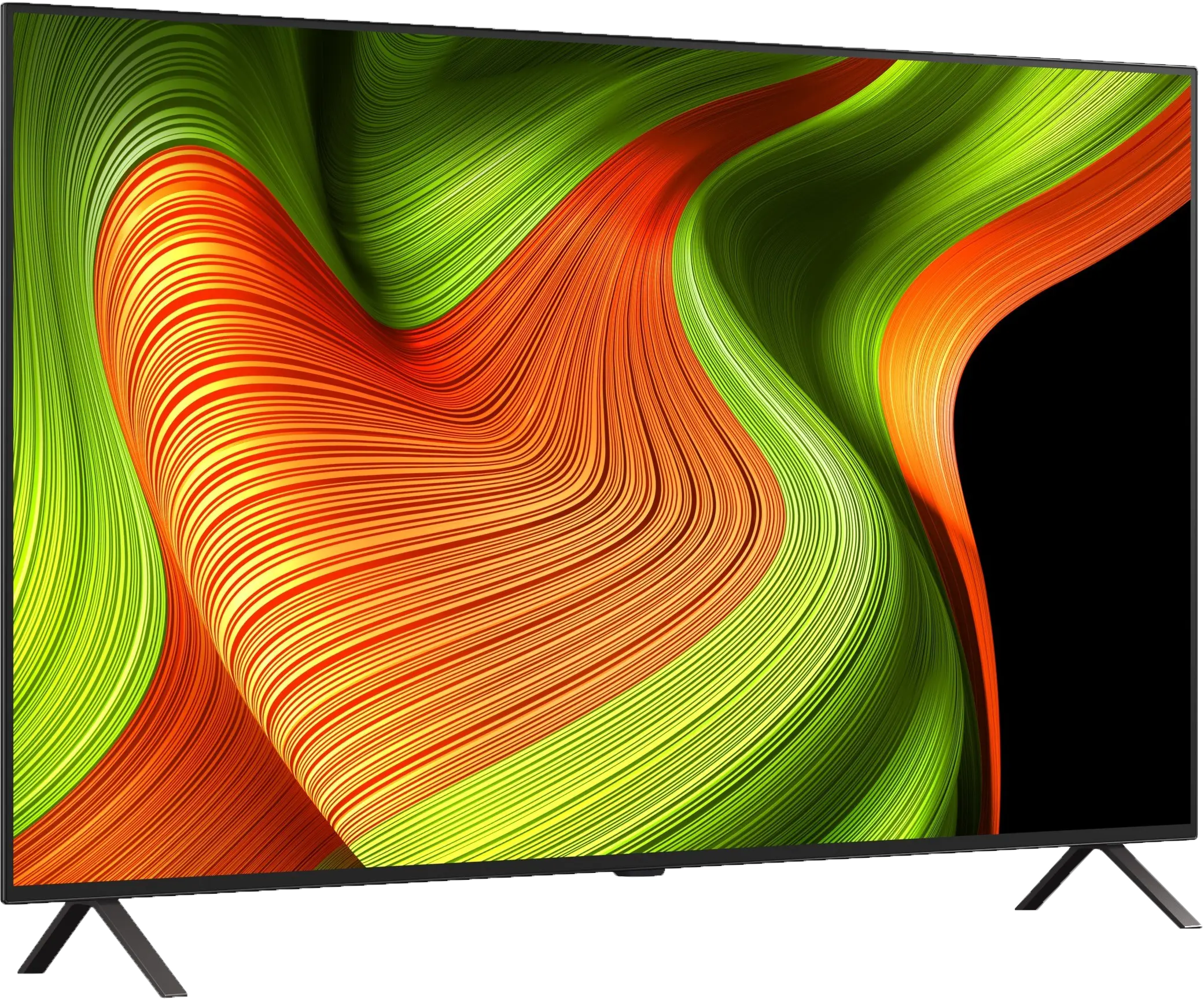

Panel type: WRGB OLED
Resolution: 3840x2160
System: WebOS
Model year: 2025
Complete the survey to find out the result

Panel type: WRGB OLED
Resolution: 3840x2160
System: Google TV
Model year: 2025
Complete the survey to find out the result

Overall rating
7.8
8.5
Movies and series in UHD quality
7.9
8.9
Classic TV, YouTube
8.6
8.8
Sports broadcasts (TV and apps)
8.5
8.5
Gaming on console
9.2
9.5
TV as a computer monitor
7.6
6.5
Watching in bright light
4.9
7.3
Utility functions
7.9
6.4
Apps
9.1
9.6
Sound quality
7.0
9.5
Complete the survey to find out what fits your preferences
Advantages
Perfect black and contrast
Pleasant image in HDR format
Excellent colour reproduction capabilities
120Hz OLED panel - great motion fluidity
4 HDMI 2.1 ports and full support for gamers (VRR, ALLM, Dolby Vision Gaming, HGiG)
Very low input lag
Correct content scaling and good digital processing
User-friendly webOS system with a Magic remote
Built-in USB recording function from built-in DVB-T/T2 tuners
Remarkable brightness, over 2000 nits in HDR!
Perfect black levels and very high contrast
Support for all major HDR formats: Dolby Vision and HDR10+
Very low input lag, amazing for gaming
Excellent motion smoothness, 144 Hz refresh rate and support for VRR and ALLM.
Four-sided Ambilight system making a huge impression
Google TV with a massive library of apps and efficient Google Assistant.
One of the best sounding televisions thanks to the Bowers & Wilkins soundbar
Support for audio formats Dolby Atmos and DTS:X
Disadvantages
Average brightness and poor performance in bright rooms
No support for DTS formats
Different remote versions in derivative models – difficult to predict which version we will receive
Only two HDMI 2.1 ports instead of four (this may be a limitation with more than one console)
Average font readability when working with a PC due to the lack of full chroma 4:4:4
Lack of several classic features – PiP, USB recording, infrared remote control
Price compared to the competition
Our verdict
Philips OLED910 is one of the candidates for the title of TV of the Year 2025 – and we say this with full conviction. Thanks to the META panel used, specifically the Tandem OLED produced by LG Display, we get top-notch brightness that has not been seen in WOLED televisions before. Combined with perfect contrast, this provides unmatched experiences for evening viewing, which are difficult to find elsewhere. And if we add the four-sided Ambilight system to this, evening screenings can look better than on any other television. The OLED910 is not just a screen for films but also an excellent choice for gamers. The fast 144 Hz panel, along with the suite of features for gamers, does the job and gives the impression that this is equipment designed with modern gaming in mind. The sound is also worthy of special mention – in our opinion, it's the best built-in speaker system we've encountered in a television so far. The soundbar, created in collaboration with Bowers & Wilkins, demonstrates that one can do without an external setup, and if someone wishes, they can always add a subwoofer and step up to a full-fledged home cinema level. Of course, it is not the cheapest model, and compared to competitors, it requires digging deeper into your pockets. But it also has a few aces up its sleeve that make the extra cost seem justified. The question is: are you ready to spend more to have Ambilight, Bowers & Wilkins soundbar, and Tandem OLED panel? This is something everyone must evaluate for themselves. We can say one thing – by choosing the OLED910, you are purchasing one of the most interesting televisions of 2025.
TV appearance
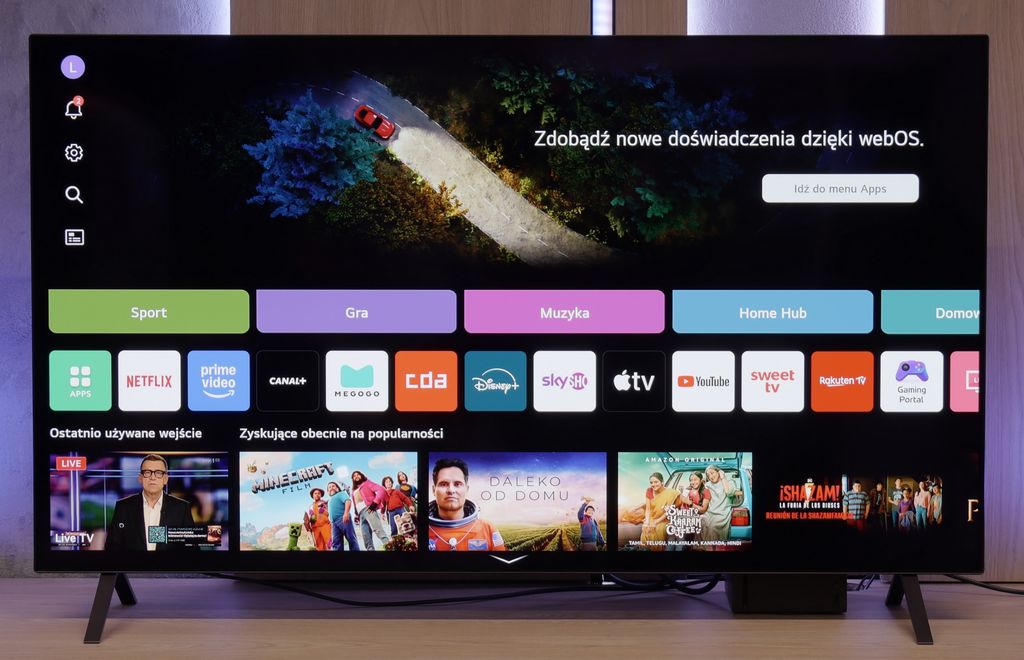
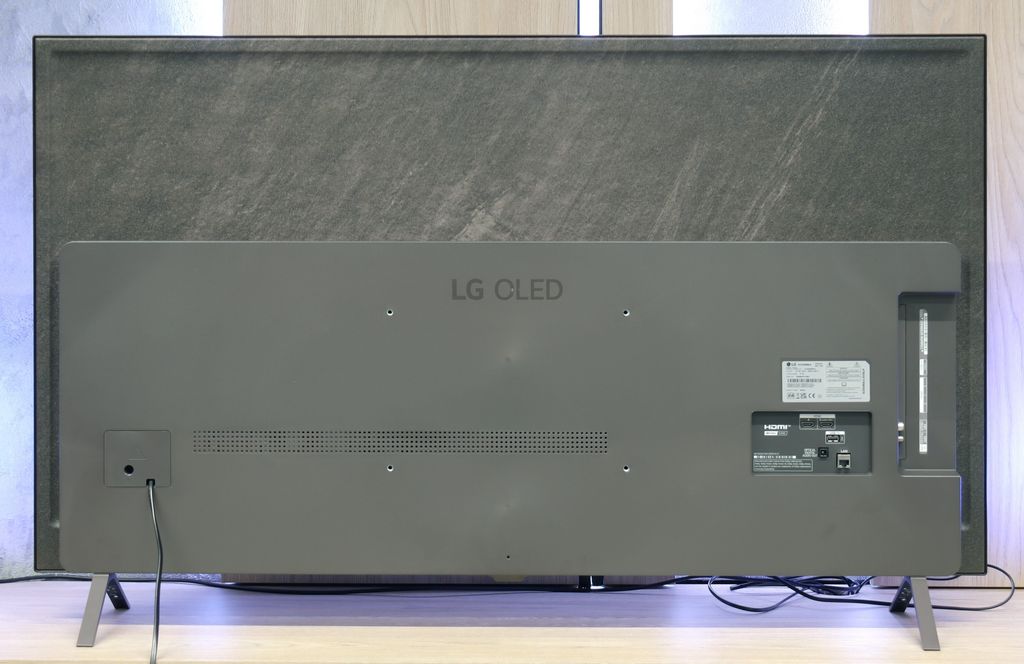
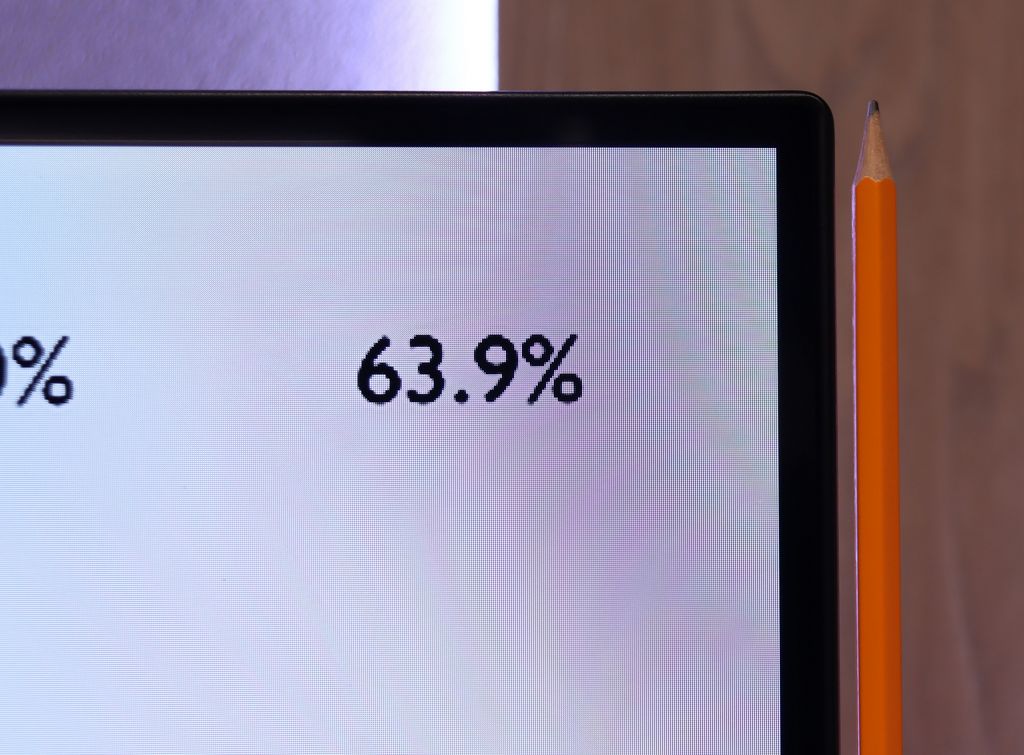




Contrast and black detail
10/10
10/10
Contrast:

Result
∞:1

Result
∞:1

Result
∞:1

Result
∞:1

Result
∞:1

Result
∞:1

Result
∞:1

Result
∞:1

Result
∞:1

Result
∞:1
Halo effect and black detail visibility:
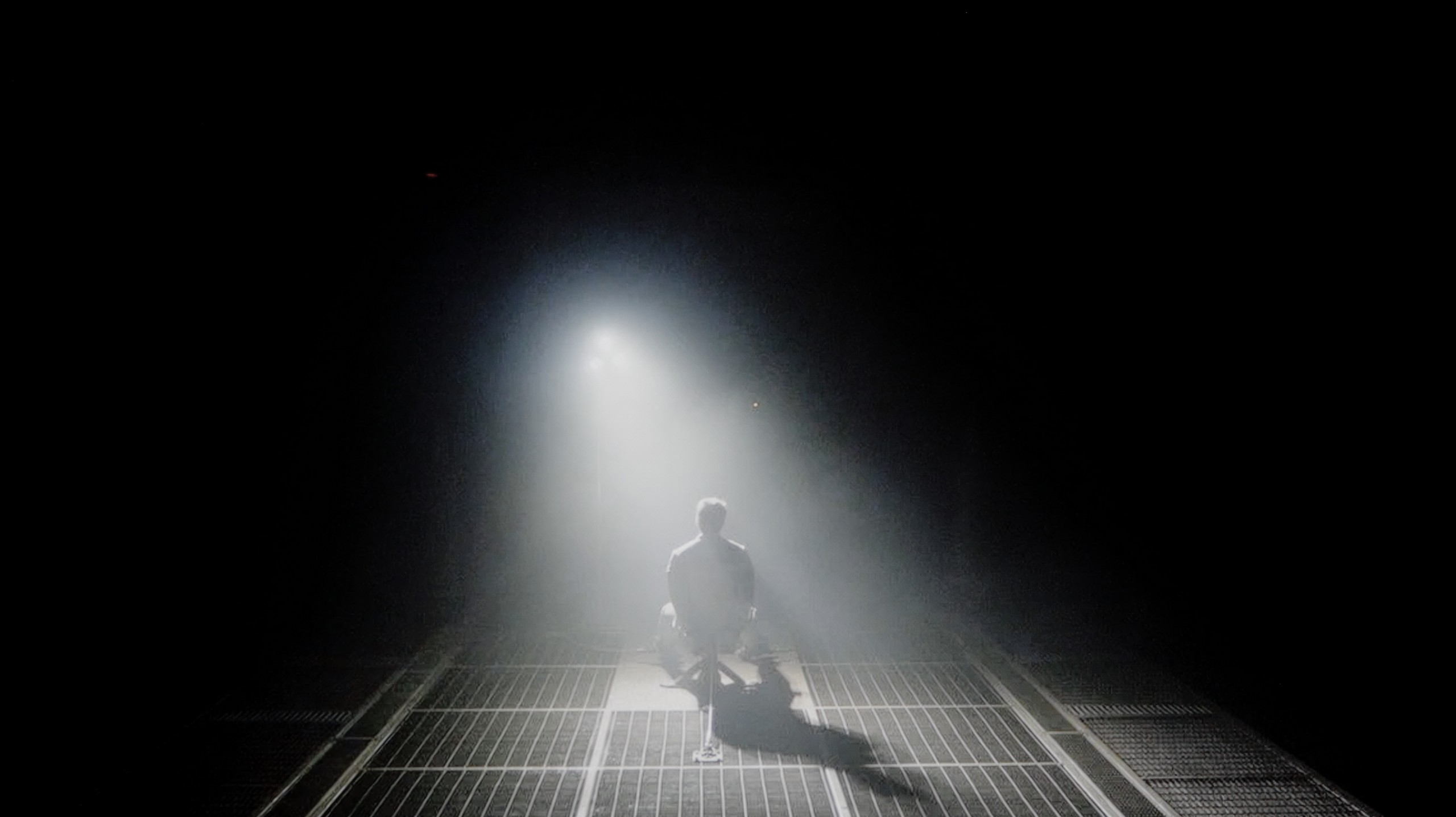

If you are looking for changes compared to last year's LG B4, we will immediately dispel any doubts – you won't find any in this category at all. And that's good. Because how to improve something that is already bordering on perfection? The LG B5, as a television with an organic WOLED panel, offers black as tar scenes and a contrast that is hard to find even in the most expensive LCD screens. The display is as clear as a bell – no bleed-through, no streaks, no halo effects that can ruin the atmosphere in cinema scenes. Here, everything is in its place. Details separate from the black with surgical precision, nothing blends together, even in the most demanding sequences from films such as The Revenant or Oblivion. This is the type of television that can enchant you, especially when the room goes completely dark. When the lights go out, the LG B5 takes centre stage – and it does so spectacularly. In these conditions, OLED shines the brightest, and even top LCD models – despite advanced dimming and hundreds of zones – simply fall behind.
As expected of an OLED television, the Philips OLED910 also offers an absolute level of black and remarkable contrast. This is a natural advantage of organic technology – each pixel is controlled independently, so when it needs to be black, it simply turns off. The image gains a depth that even the best Mini-LED televisions cannot reproduce, where there is always a risk of slight "blooming" or halo effect around bright elements. With the OLED910, this is not an issue – dark scenes are entirely credible, and at the same time, the television can replicate details in highlights with great precision, preserving their natural structure. In everyday viewing, this translates to an exceptional sense of realism and a cinematic quality. In this category, the OLED910 undoubtedly deserves the highest marks.
HDR effect quality
6.2/10
8.8/10
Luminance measurements in HDR:

Result
587 nit

Result
593 nit

Result
628 nit

Result
589 nit

Result
470 nit

Result
2008 nit

Result
2109 nit

Result
2214 nit

Result
2152 nit

Result
1382 nit
Scene from the movie “Pan” (about 2800 nits)


Scene from the movie “Billy Lynn” (about 1100 nits)


Static HDR10


Dynamic: Dolby Vision
Dynamic: Dolby Vision


HDR luminance chart:
Philips OLED910
HDR luminance
Luminance of RGB colors
LG OLED B5
HDR luminance
Luminance of RGB colors
The LG B5 is a moderately bright OLED television. Regardless of the scene, it can generate around 500 nits of peak brightness. Interestingly, it achieves this even in full-screen shots saturated with white, where most OLEDs typically struggle. So is this screen suitable for HDR films? Indeed – and very much so, because such brightness allows you to truly feel the magic of HDR effects. However, it is worth noting that compared to last year's B4 model, the new B5 is darker – by about 100 nits. It may seem like a small amount, but at such average peak values, it makes quite a significant difference. Fortunately, the television compensates with another advantage – excellent coverage of the DCI-P3 and BT.2020 colour gamut. As a result, HDR films look really colourful, vibrant, and impress even in more demanding scenes.
The OLED910 is simply an absurdly bright television for an OLED. All thanks to the new panel from LG Display, the Tandem RGB OLED, which Philips has dubbed its "META OLED." It is this panel that allows for over 2000 nits of brightness in films, which not long ago was completely unattainable in OLEDs. The television also deserves high praise for how it handles full-screen scenes drenched in bright light. Generally, in OLEDs, brightness drops significantly during such scenes, but here it remains at an excellent level – around 1400 nits. These are almost reference values, and combined with the excellent colour reproduction at 99% DCI P3 and 82% BT.2020, it gives us an HDR effect that can confidently be called one of the best in the world.
Factory color reproduction
8.2/10
5.5/10


Factory Mode
After calibration


Factory Mode
After calibration
We tested the B5 in Filmmaker mode and... we would love to see more TVs like this straight out of the box. Truly. The white balance is set very well – there's practically nothing to complain about. Well, if one were to nitpick, one might notice a slight deficiency in blue, which makes the overall image seem slightly yellowish. But that’s just our editorial quibbling. Most of you probably wouldn’t even notice it. We also have minimal reservations about brightness management in HDR format. The EOTF curve – which is responsible for how the TV distributes brightness in a scene – is slightly below ideal. In practice, it may happen that the darkest parts of the image are displayed too dark and simply… disappear. But these are details that only come out in measurements. Generally: we are impressed. However, we also know that LG TVs respond very well to professional calibration. You can achieve almost reference-quality picture from them, so – while it's already very good out of the box – we allowed ourselves to go a step further and refine everything to perfection.
Unfortunately, when it comes to colour reproduction straight out of the box, the Filmmaker mode on the OLED910 performs really poorly. The television overemphasises the blue colour, and at times it looks almost like a shop display mode. This gives the impression that the manufacturer hasn’t quite tuned the device properly. The effect is that the colours look unnatural, and the whole thing resembles a somewhat exaggerated display from a market exhibition. HDR content is presented much better, where, apart from a slight loss of detail in the blacks, there’s not much to complain about. The problem is that in everyday viewing, it’s the SDR materials that matter the most – and on the OLED910, they simply look poor and fall well short of what we would expect from a television of this class.
Color reproduction after calibration
9.1/10
9.4/10




We must admit that we didn't have much work with the LG B5. It's one of those televisions that look good right from the start, but after calibration… they can really impress. The white balance was brought to almost perfect levels – to the point of errors that are invisible to the human eye, unless you are a professional colourist with a magnifying glass at the screen. We also managed to master the tendency of the television to slightly dim the darkest details, particularly in HDR scenes. After proper tuning, everything looks cohesive: black remains deep but does not consume information. Highlights maintain their natural sparkle, and colours align with the director's vision. This is truly one of those models that shows you don't have to spend a fortune to have an almost reference-quality picture. If you can opt for professional calibration – it’s definitely worth it in the case of the B5.
Fortunately, it quickly turned out that it was not the panel causing the problems, but rather the way Philips factory-calibrated the OLED910. After calibration, the television displayed its full potential, and only then could we see what the new panels produced by LG Display were truly capable of. We primarily adjusted the white balance and brightness characteristics, successfully taming the excessive blue and giving the image a natural appearance. The final effect can be described as excellent. Errors on the Color Checker palette rarely exceeded a value of 3, which in practice means an image close to perfection and colours presented in accordance with the creators' intent. In SDR content, the effect was outstanding, and in HDR, the improvement was even more noticeable – gradients became cleaner, and colours fuller and more accurate. After calibration, the OLED910 transformed from a disappointing television into equipment that can confidently be referred to as a reference in terms of colour quality.
Smoothness of tonal transitions
7.2/10
7.5/10






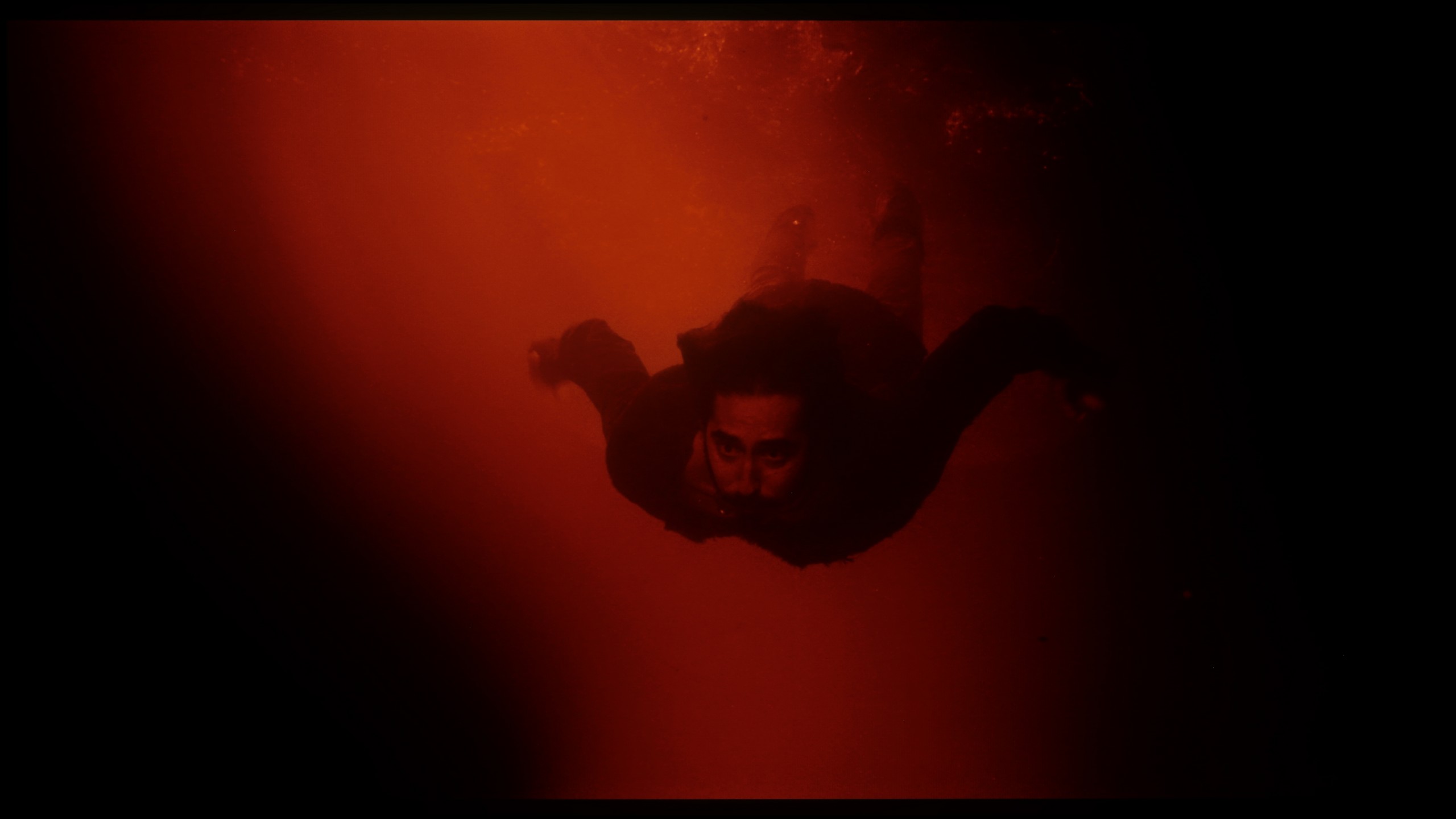





The LG B5 handles colour gradation quite decently. In bright scenes, where we have smooth transitions between skin tones, the sky, or backgrounds, the television blends colours seamlessly and without any jarring effects. At first glance – it looks good, especially considering the price. However, it is enough to reach for more challenging material – those darker, more demanding scenes with a lot of subtle transitions – and the challenges begin. Minor artefacts, false contours, and slight thickening appear. It is still not a level that dazzles or distracts from the narrative, but the difference compared to more expensive WOLED models – and even more so QD-OLED screens – becomes noticeable.
When it comes to colour combinations, the OLED910 performs quite well. In bright scenes, especially where strong bright colours dominate, it is difficult to spot any serious problems and the image looks very clean. It is less impressive in darker sections, closer to the grey palette – there you can notice characteristic banding, which may start to irritate more demanding viewers after a longer period of watching. Overall, however, it is a decent level and in most films or series, the effect should not be particularly bothersome.
Image scaling and smoothness of tonal transitions
7.5/10
7/10
Smooth transition function
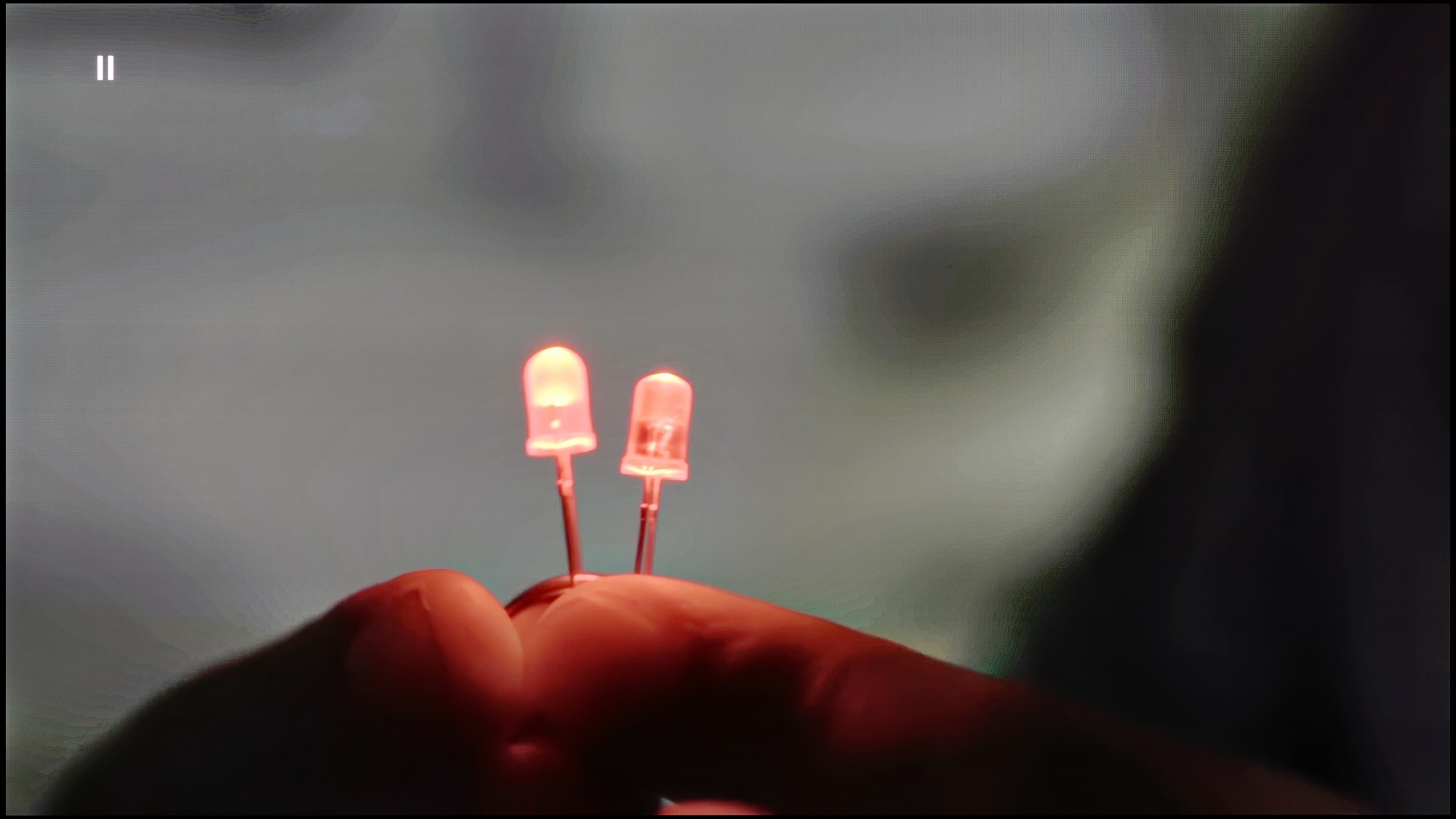

Image without overscan on the SD signal


LG B5 really positively surprised us in terms of handling lower quality content. Thanks to the enhancement and smoothing features, materials in HD resolution or even SD gain a second life. Importantly – when this option is activated at the "low" or "medium" level, we do not feel that the image is artificially softened or smoothed out unnecessarily. Details remain intact, film grain does not disappear, and the edges of objects do not look washed out 😉. This is truly a useful tool – especially if you are watching terrestrial television, archival materials, or content from YouTube in lower resolutions. The image is clear, coherent, and simply pleasant to the eye.
Scaling as such works very well – even content of poor quality is reproduced with surprising fidelity. Unfortunately, there was a slight hiccup. Although the menu contains the option to disable overscan, the television still has issues with correctly displaying images of very low resolution. It may seem like a detail, but when watching older materials – it can be irritating.
The previously visible colour banding can largely be mitigated thanks to a feature called "distortion reduction." Like in the OLED820, it is best set to a medium level, as it then produces fairly decent results – smoothing out unwanted tonal transitions while not taking away too much detail from the image. Although at times the effect may be slightly too aggressive, this function can be considered useful for everyday viewing.
As for image scaling, the OLED910 performs really well. The test material featuring a model had a soft look characteristic of Philips – at times almost too soft – but this can be easily corrected with the sharpness slider, allowing you to adjust the image to your own preferences. It's also worth noting that the television has no issues with overscan, which still occurs in some competitor models. It's a small detail, but it's pleasing because it means that all content, even the oldest, is displayed as it should be.
Blur and motion smoothness
8.5/10
8.5/10
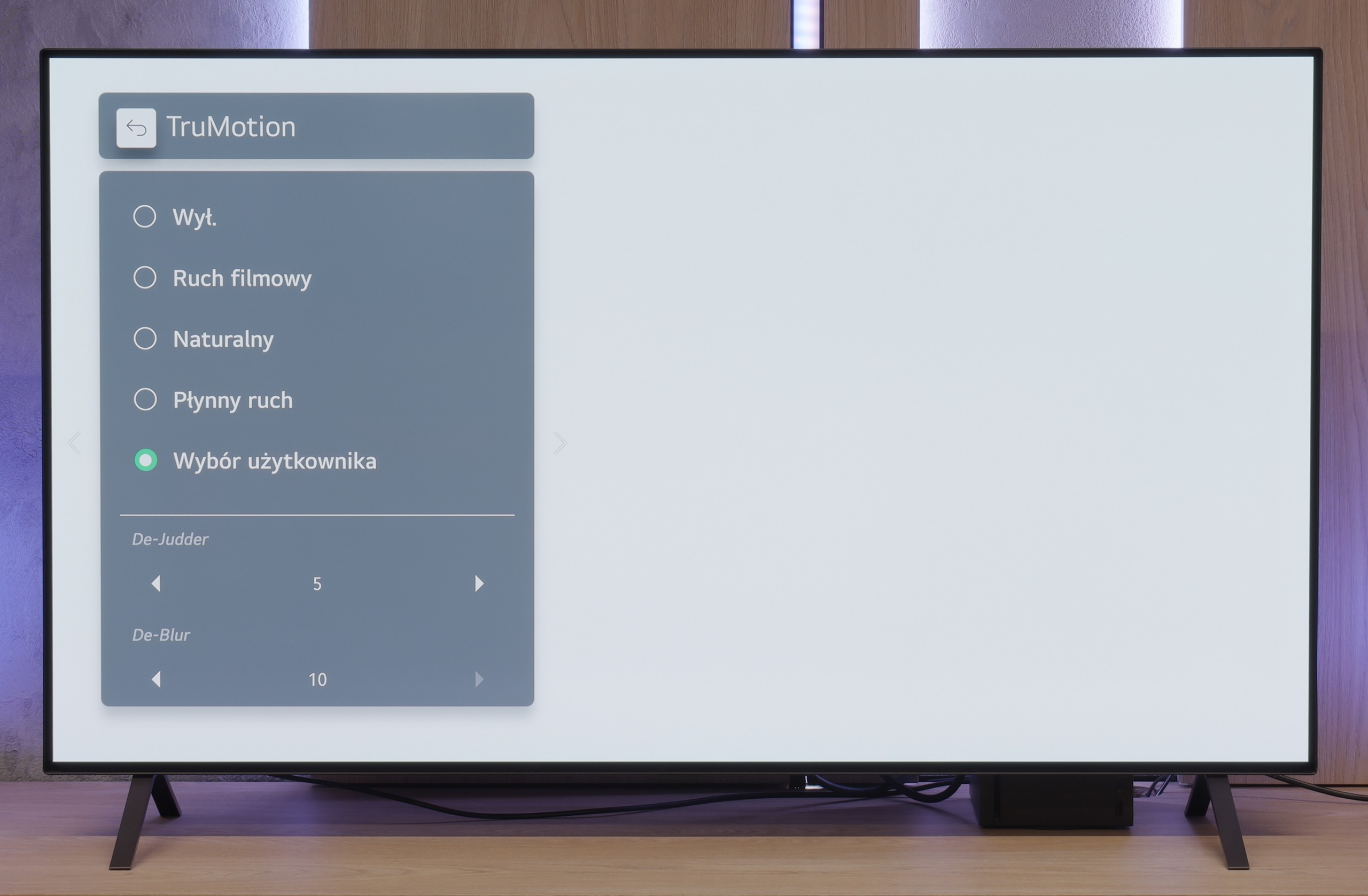

Blur (native resolution, maximum refresh rate):

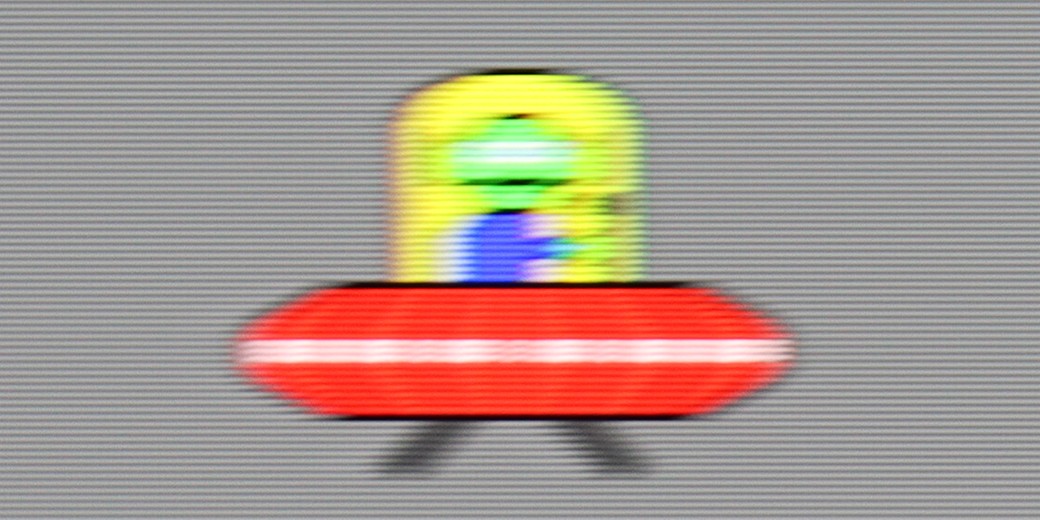




Smużenie ():
Smużenie (4K@144Hz):



LG B5 is a television with a 120 Hz OLED panel. It may not sound as impressive as the marketing claims of “144 Hz” or “165 Hz” found in gaming monitors, but honestly? The smoothness is excellent nonetheless. The picture is sharp, fluid and simply enjoyable to watch – even when there is a lot happening on screen. The organic panel does its job – the pixel response time is almost instantaneous, meaning there’s no sign of smearing or blurring that can spoil dynamic shots. Sport, fast-paced games – everything looks clear and distinct.
We also have the classic LG smoothness enhancer, TruMotion. This allows you to smooth out films shot at 24 frames per second – which, to put it bluntly, is most of what you watch on Netflix or from Blu-ray discs. If you set lower values on the “De-Judder” slider, you’ll get a picture closer to a cinematic look – with a slight judder, but without any artificiality. Higher settings? A soap opera effect is guaranteed. Fortunately, LG gives you the option to tune everything to your liking.
OLED910 is a television with a refresh rate of 144 Hz. It’s a bit of a shame that Philips didn’t opt for 165 Hz, as we know that the panel used is capable of that. On the other hand, such a bonus would mainly benefit PC gamers, as in everyday use, the most important refresh rate is 120 Hz, which is fully sufficient. Combined with the advantages of the OLED panel – lightning-fast pixel response time and the absence of motion blur, the image is impeccably sharp and quick, even in dynamic action scenes. The traditional motion smoother from Philips, called “Motion Style,” also deserves praise. We can easily adjust it to our preferences: the “Fluidity” slider is responsible for films and allows you to choose between a more “filmy,” cinematic character and a smooth, theatrical image. Meanwhile, the “Motion Blur Reduction” slider is intended for sports, where it’s worth setting it to the maximum value to ensure that the image is clear and distinct during very fast shots.
Console compatibility and gaming features
10/10
9.8/10
- ALLM
- VRR
- VRR range40 - 120Hz48 - 144Hz
- Dolby Vision Game Mode
- Correct implementation of HGIG
- 1080p@120Hz
- 1440p@120Hz
- 4K@120Hz
- Game bar
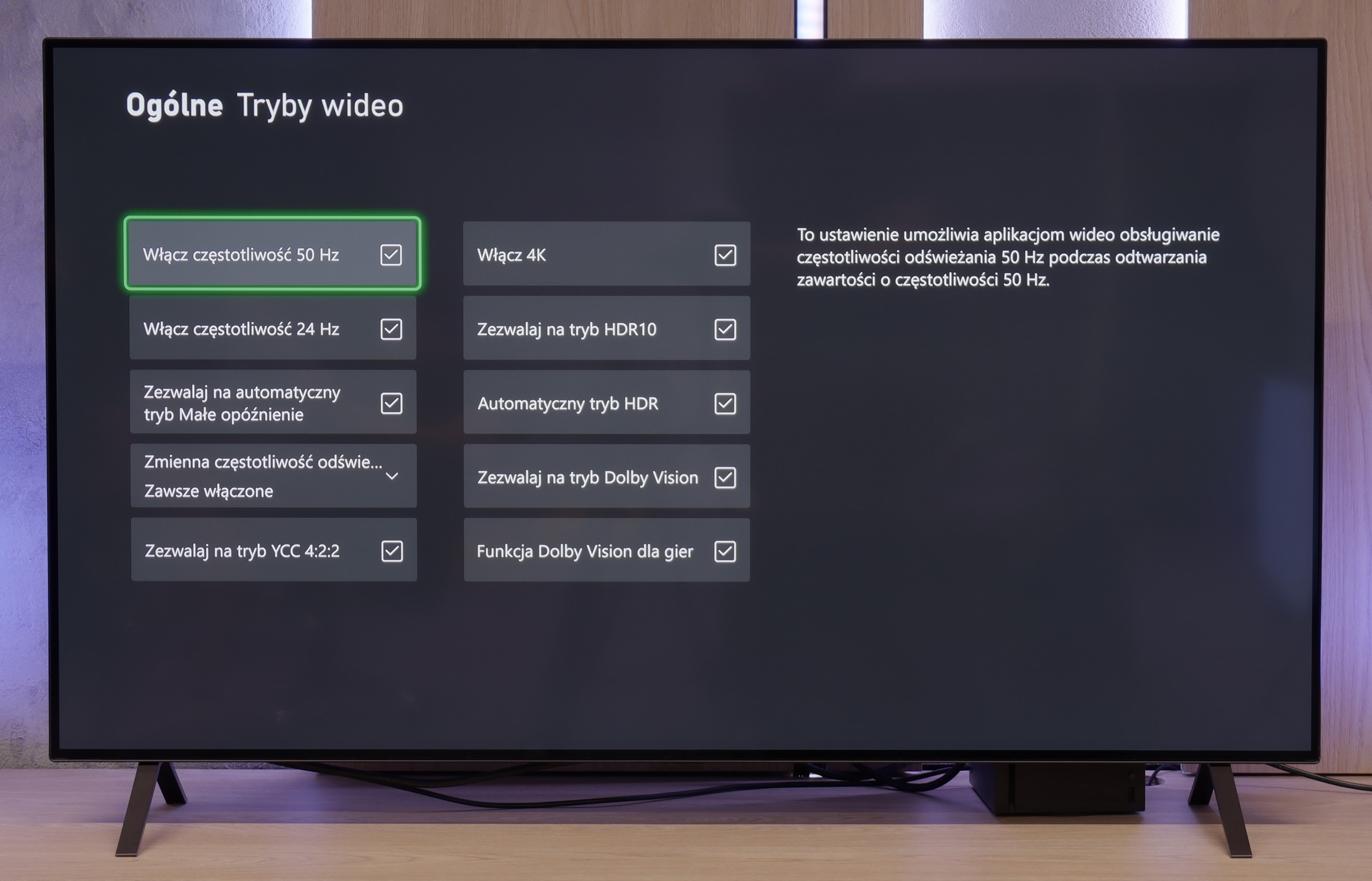

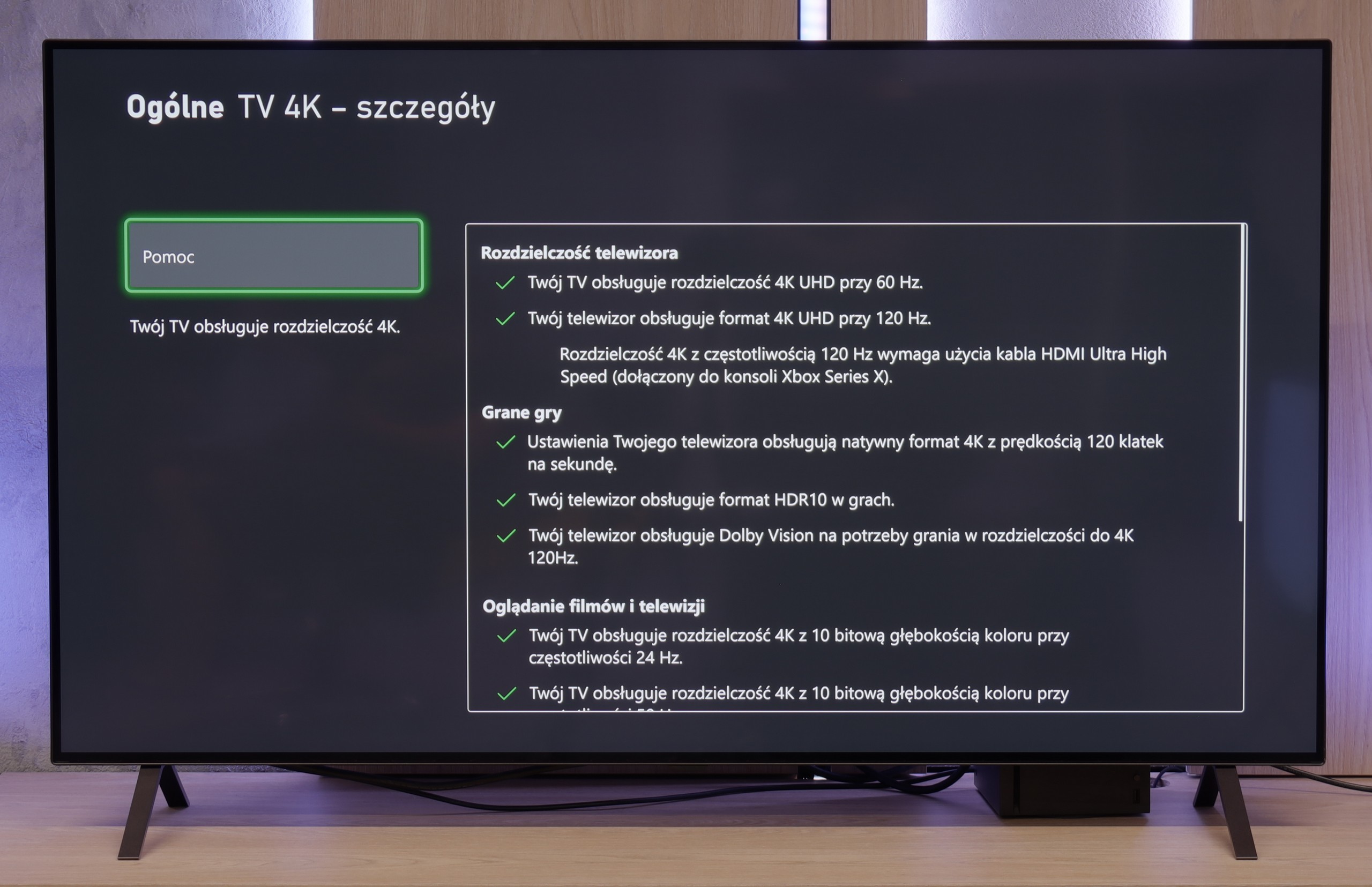

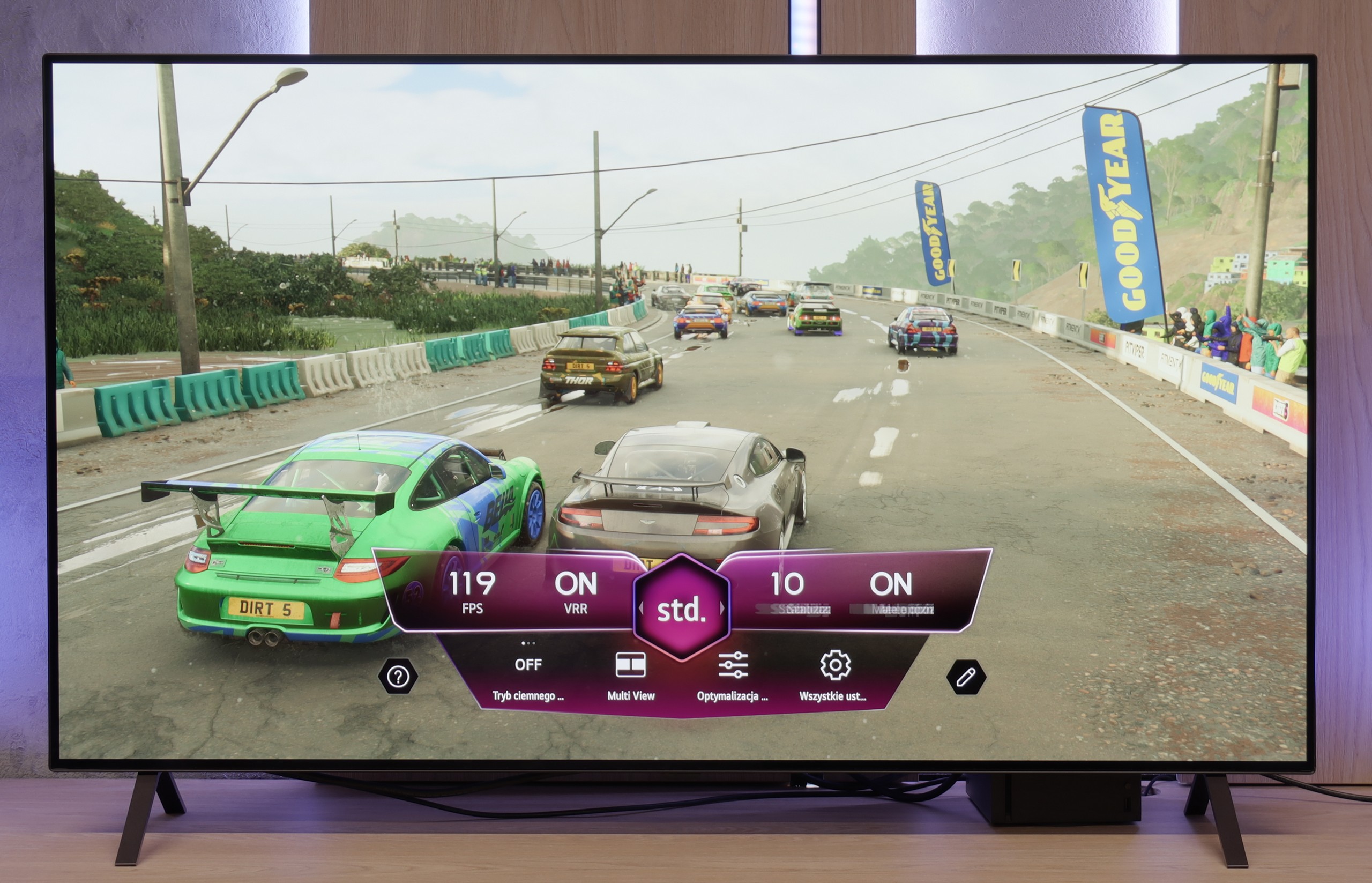

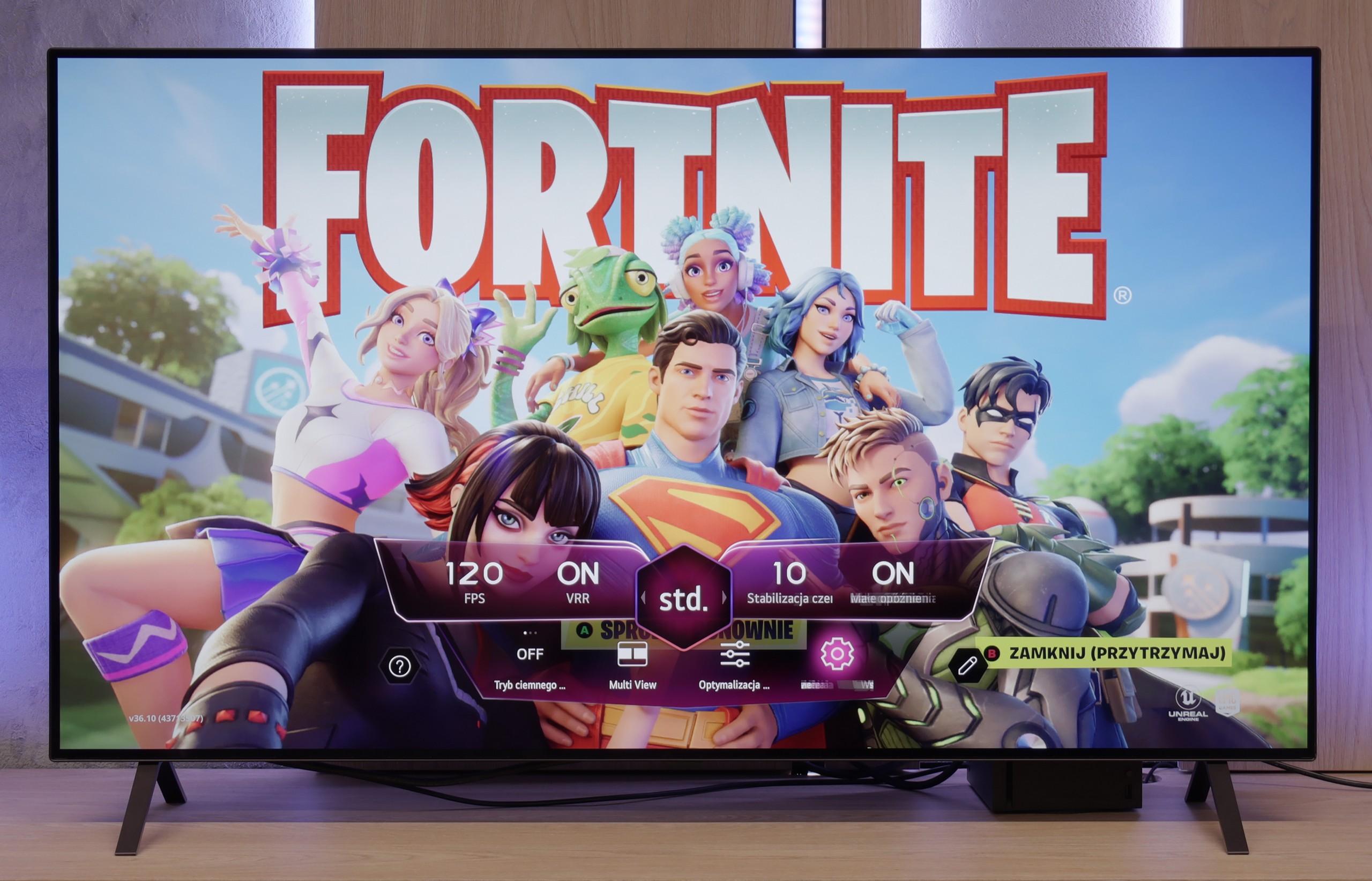

There are already a few televisions on the market with the label “for gamers” that, in practice, don’t understand what that means. The LG B5 is not one of them. Everything here is spot on – there are four HDMI 2.1 ports, it has 120 Hz, VRR, and ALLM, and it even has a Game Bar that is actually useful, not just looks good in the brochure. You connect your console – it works. You set 4K at 120 Hz – it works. You have an Xbox and want to play in Dolby Vision – it works too. And this is not in the sense of “theoretically supports”; it really turns on, looks good, and you don’t need to fiddle with the settings for half an hour. Additionally, there’s the HGiG picture mode that LG implemented correctly – which means HDR in games doesn’t turn the screen into a flash lamp, but shows exactly what it should. There are no surprises here, no strange limitations, no “buts.” And you know what? That’s how it should be. Cheers to the LG B5!
The OLED910 is fantastic for gaming. It supports 144 Hz, so if someone has a powerful PC, they can comfortably utilise that potential. On consoles, the most important thing is still 120 Hz, and everything works perfectly here. There's VRR, an automatic gaming mode, and even Dolby Vision in games and HGiG mode, so we really get a full package of gaming features. Philips has also added a Game Bar, which is a quick menu that displays basic information and allows you to enable a few useful things. It may not look as modern as the competition, but it works and fulfils its purpose. The only downside is the number of HDMI 2.1 ports. There are only two, which can be quite disappointing for a TV in this class. If someone connects two consoles and something additional through eARC - like a soundbar (which doesn't make much sense in this model but I'll discuss that in the paragraph about sound) - they'll have to do some adjustments. Other than that, the OLED910 has everything we expect from a gaming television.
Input lag
9.9/10
10/10
SDR
HDR
Dolby Vision
Here we won't elaborate – the LG B5 simply has excellent input lag. For 60 Hz content, it achieves results below 10 ms, and for 120 Hz it even drops to around 5 ms. These are values that cannot be fairly critiqued. It simply works instantly, with no delays, no surprises. Well… almost. Because as usual, there is a small asterisk with the Dolby Vision Gaming mode. In this mode, the response time slightly increases. It’s nothing dramatic – they are still very low values, hardly noticeable during gameplay – but if you play exclusively competitive titles and fight for every millisecond on the XBOX, it’s worth keeping in mind.
In terms of input lag, the OLED910 has nothing to be ashamed of. In 120 Hz mode, the delay is around 5 ms, which is a reference result and guarantees instantaneous response. With 60 Hz materials, the values rise to around 13 ms, but this is still a very good result, entirely sufficient even for demanding gamers. Importantly, even in Dolby Vision, the input lag remains low, so you can enjoy both excellent picture quality and full responsiveness.
Compatibility with PC
7.6/10
6.5/10
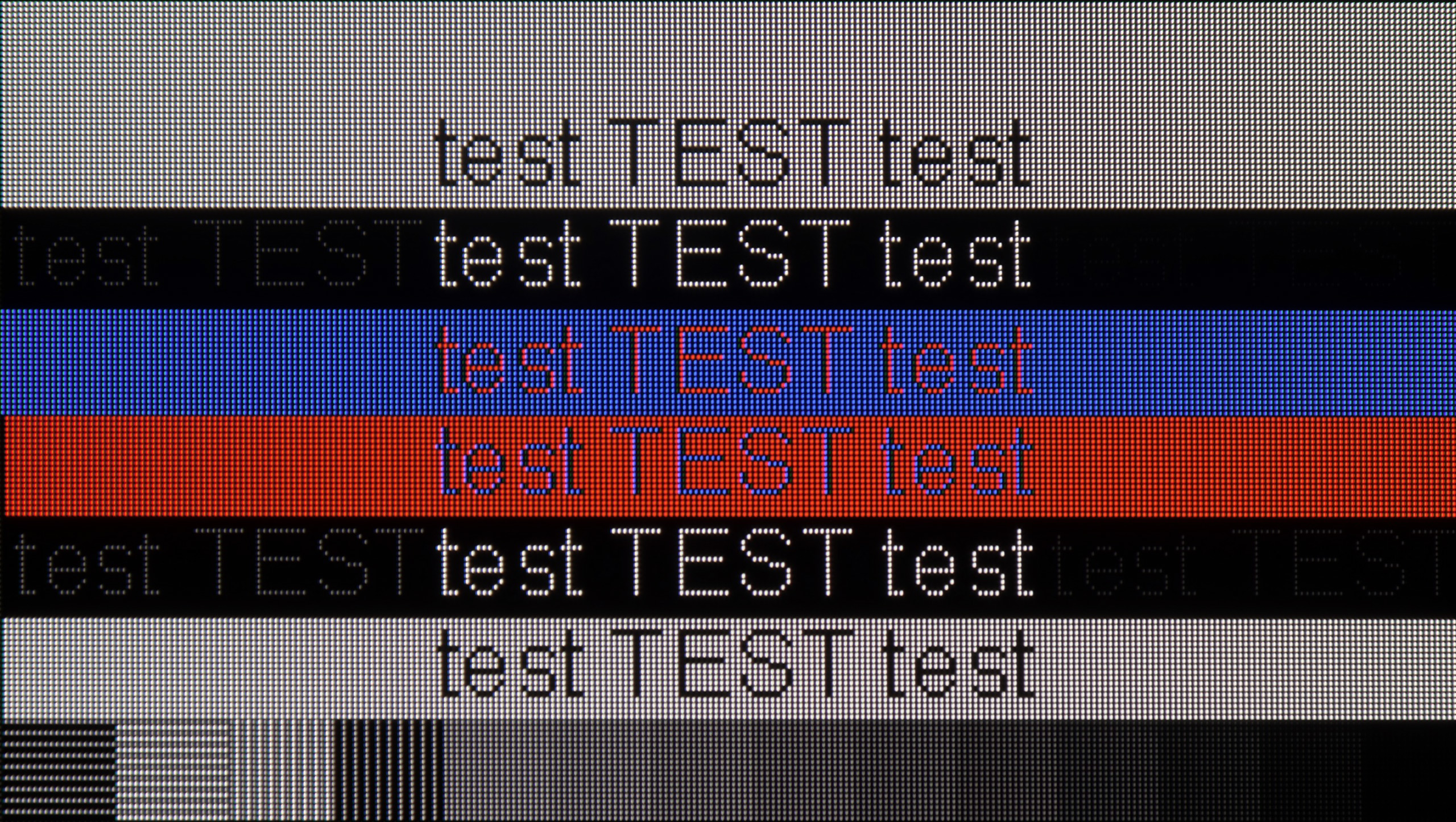

LG B5 is a television that communicates well with a computer. You won't find gaming frills like 144 or 165 Hz here, but is that really necessary for anyone? Thanks to the 120 Hz panel, low input lag, and G-Sync support, it's truly a very good screen for gaming on PC. No stuttering, no tearing, with lightning-fast response.
But it's not just for gaming. You can also quite comfortably... simply work on the B5. The television properly supports chroma 4:4:4, so fonts are readable, interfaces are clear, and your eyes won't hurt from blurred letters. This isn't a given, even among more expensive models. However, there is one 'but' – and this applies not only to the B5, but to any OLED with a WOLED panel. The RWGB subpixel arrangement can cause a slight shadow along the edges of fonts. This isn't something that stands out from the sofa. It's something that someone sitting with their nose to the screen and spending half the day in Excel would notice.
The OLED910 connected to a computer performs excellently in games. It has a 144 Hz refresh rate, very low input lag, and G-Sync support, so everything runs smoothly and without delays. For gaming, it's really hard to find any faults. It’s worse if someone wanted to work with text on it. Standard black-and-white fonts look fine, but the problem starts when colour elements appear in the document. The lack of full chroma 4:4:4 support causes such text to appear slightly blurred. For everyday office work, it’s a mediocre solution.
Viewing angles
7.4/10
7.6/10
In terms of viewing angles, the LG B5 performs very well – exactly as one would expect from an WOLED panel. No matter from which side you sit, the picture maintains its quality. The colours do not wash out, the contrast does not deteriorate, and the details remain clearly visible. However, it must be said that this is not the level of Samsung Display's QD-OLEDs. Those can hold colour saturation even better at extreme angles. But if you do not plan on watching films while sitting at a 90-degree angle – the B5 is more than sufficient. It is one of those televisions that is simply pleasant to look at – from every angle.
The OLED910 performs very well in this regard. The new Tandem OLED RGB panel means that we no longer have the advantage that older MLA panels could pull off in a showdown with QD-OLEDs. Here, instead of a "remarkable" level, we simply have "very good." Brightness does drop a bit when viewed at an angle, but colour saturation is maintained, and even with a larger deviation, the picture looks appealing. It will be difficult to find a situation where the viewing angles in this model actually bother anyone.
TV efficiency during daytime
4.9/10
7.3/10
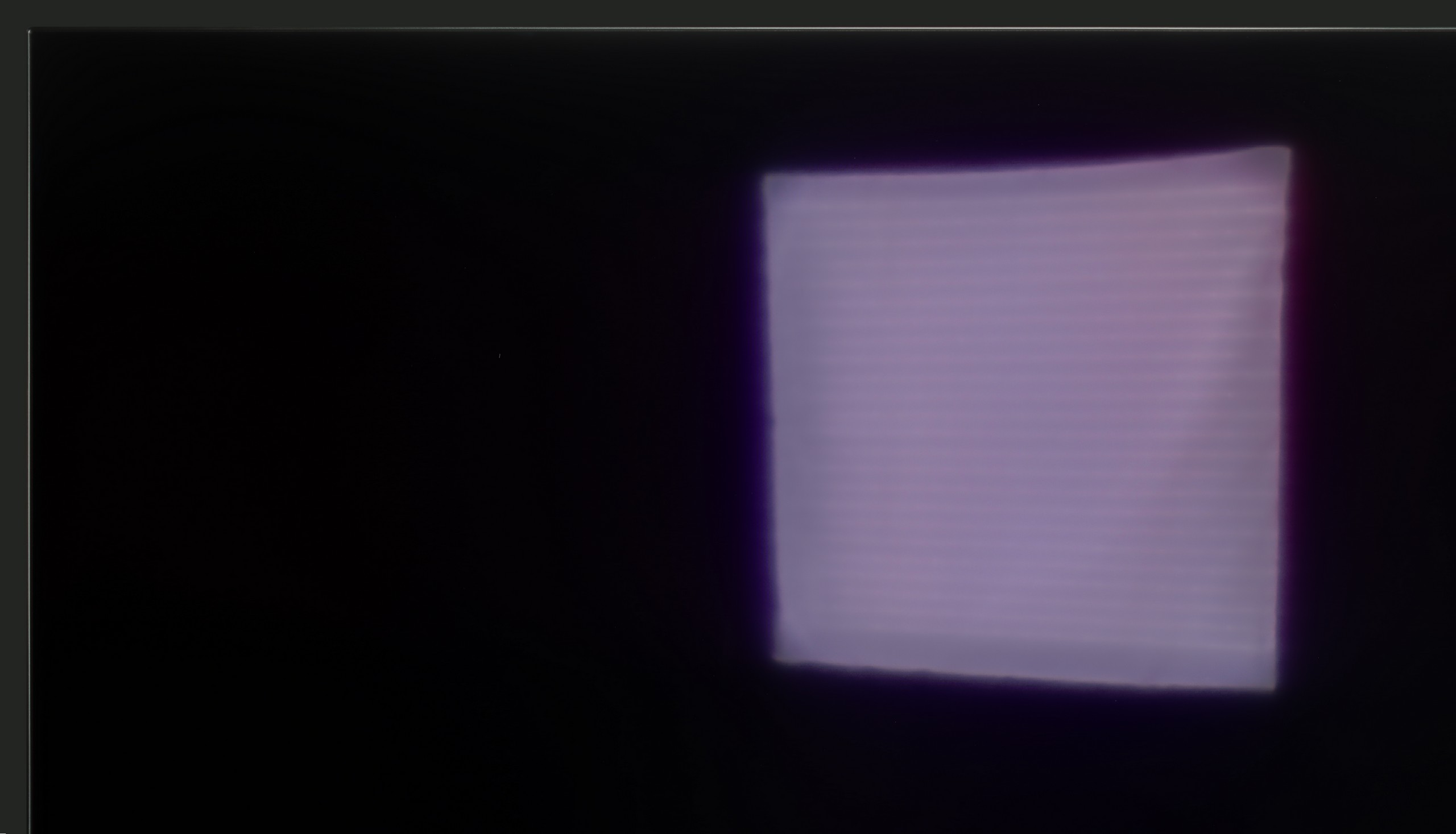



Matrix brightness
Average luminance SDR
Philips OLED910: 614 cd/m2
LG OLED B5: 279 cd/m2
LG B5 is a television that feels best after dark. But when the sun comes out, it becomes a challenge. The brightness of this model is rather average, and the anti-reflective layer... also average. There are no special coatings here that handle reflections or very bright daylight well. So if you plan to place this television opposite a large, uncovered window – it could simply be difficult to see anything.
Fortunately, there is something worth praising: the glossy WOLED panel maintains colour saturation well. Even in difficult conditions, the image does not fade and does not become "washed out," as can happen with some models of televisions. Generally, it is watchable, but if you are looking for a television specifically "for a bright living room," then the B5 should not be your first choice.
Details about the matrix
Subpixel Structure:
Panel uniformity and thermal imaging:
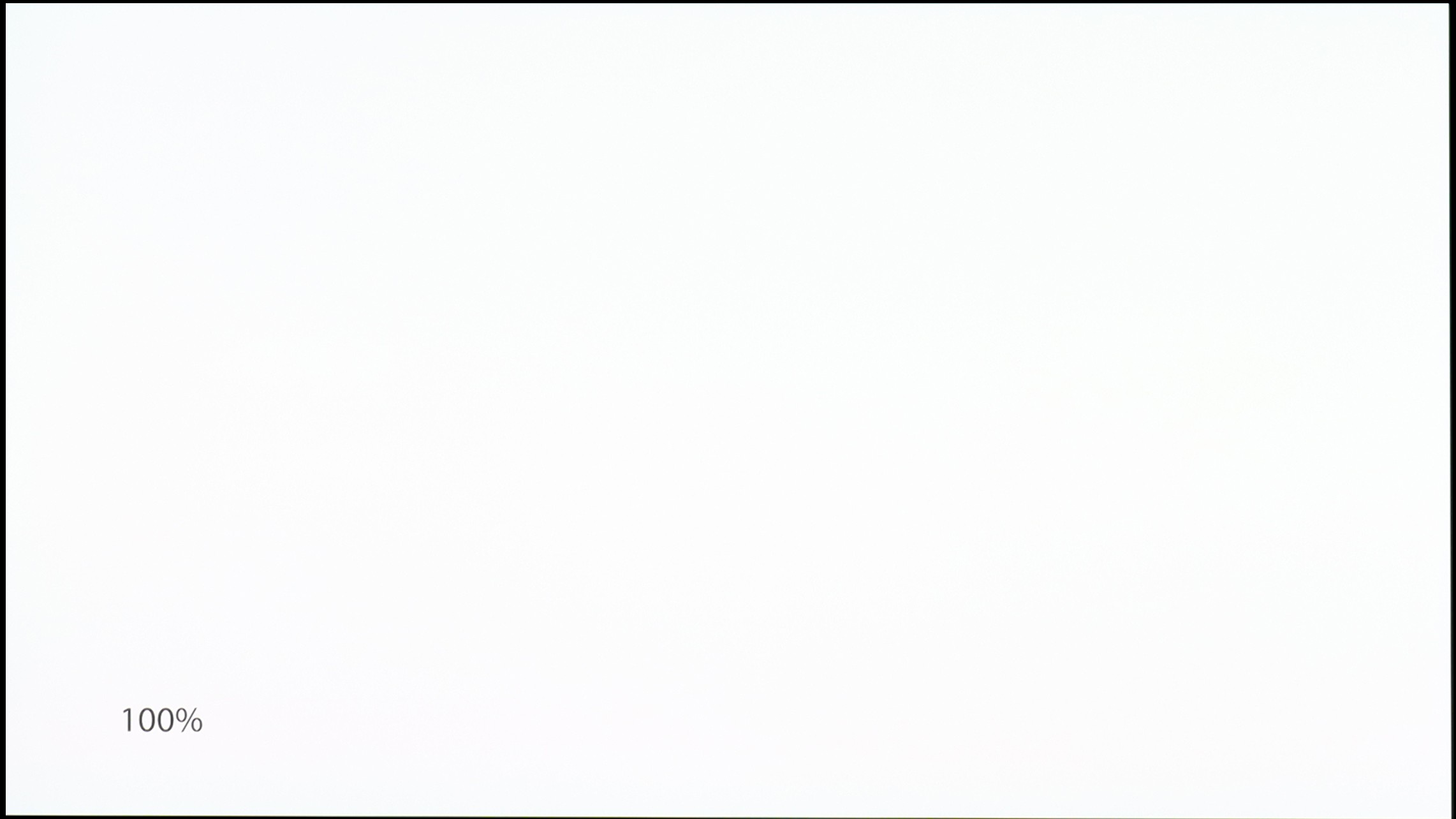

TV features
7.9/10
6.4/10
- HDMI inputs0 x HDMI 2.0, 4 x HDMI 2.1 48Gbps2 x HDMI 2.0, 2 x HDMI 2.1 48Gbps
- OutputsToslink (Optical audio), eARC (HDMI), ARC (HDMI)Toslink (Optical audio), SPDIF (Coaxial audio), eARC (HDMI), ARC (HDMI), Mini-Jack (Headphones)
- Network InterfacesWi-Fi 2.4GHz, Wi-Fi 5GHz, Ethernet (LAN) 100MbpsWi-Fi 2.4GHz, Wi-Fi 5GHz, Ethernet (LAN) 100Mbps
- TV receptionDVB-T, DVB-T2, DVB-S, DVB-S2, DVB-CDVB-T, DVB-T2, DVB-S, DVB-S2, DVB-C
Classic features:
- Recording to USB (terrestrial TV)
- Recording programming
- Picture in Picture (PiP)
- RF remote control (no need to aim at the screen)
- Backlit remote control
- Teletext
- Audio only mode
- Bluetooth headphones support
- Simultaneous Bluetooth headphones & TV audio
Smart features:
- AirPlay
- Screen mirroring (Windows Miracast)
- Voice search
- Voice search in native language
- Ability to connect a keyboard and mouse
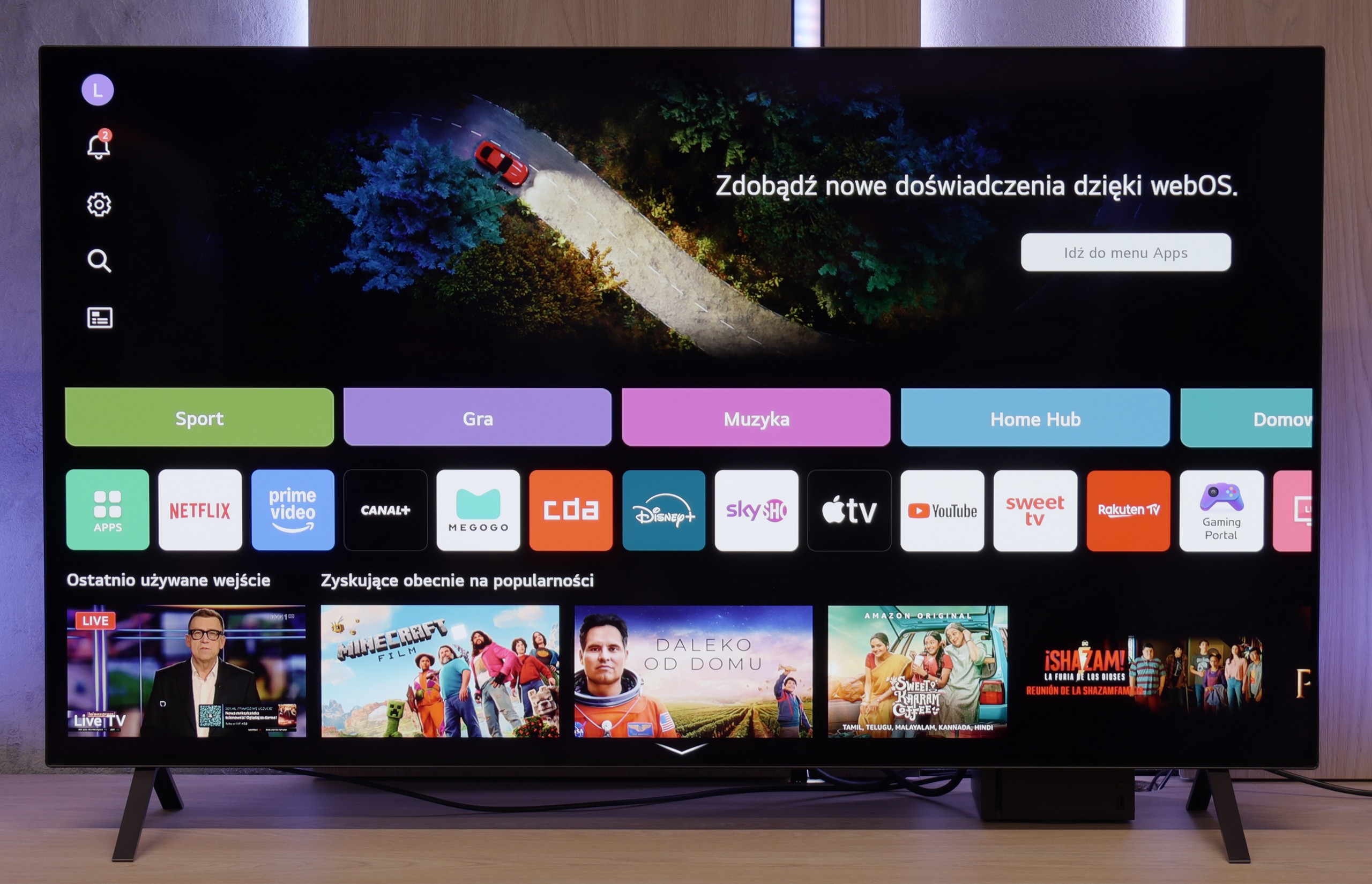
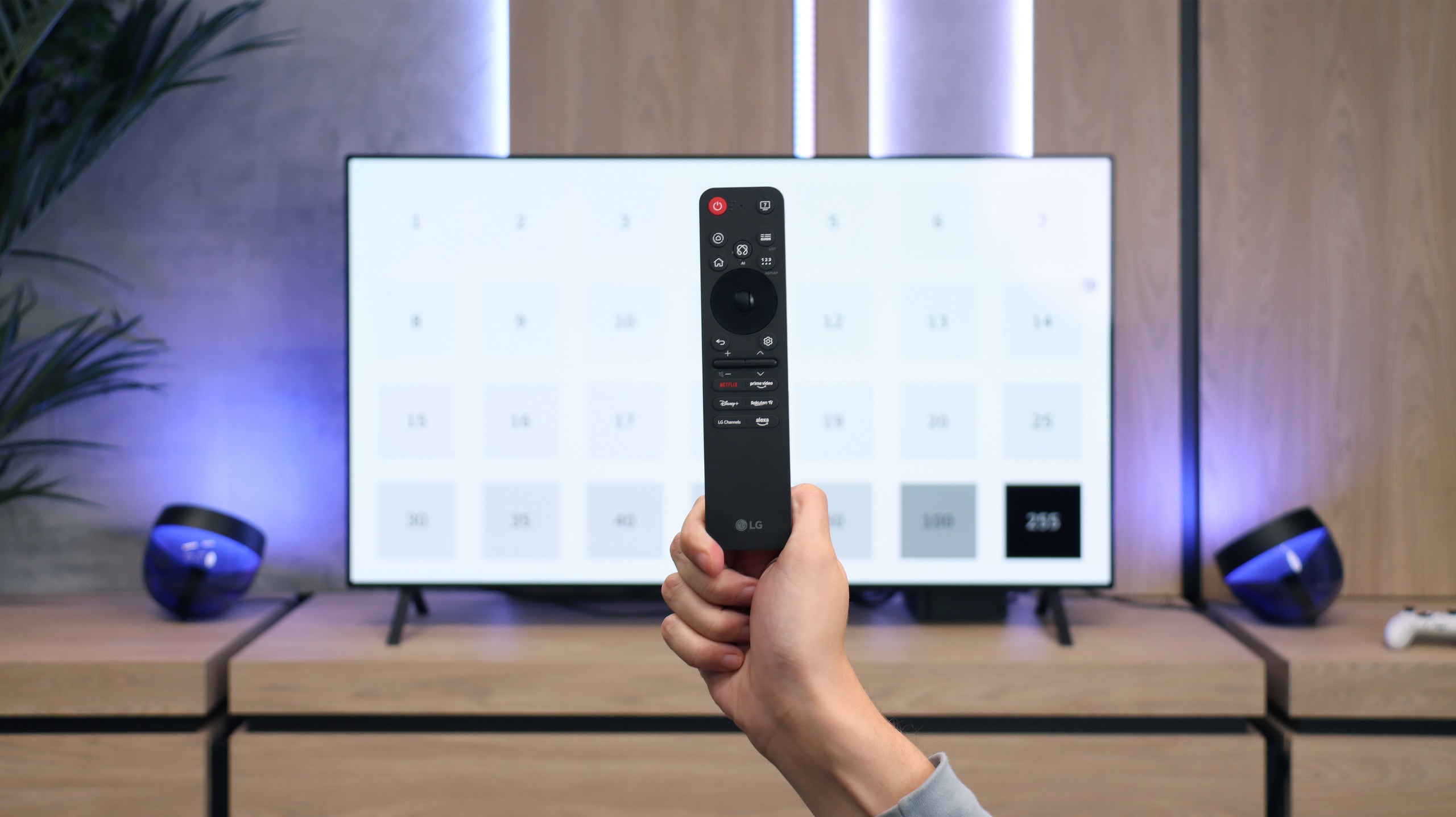
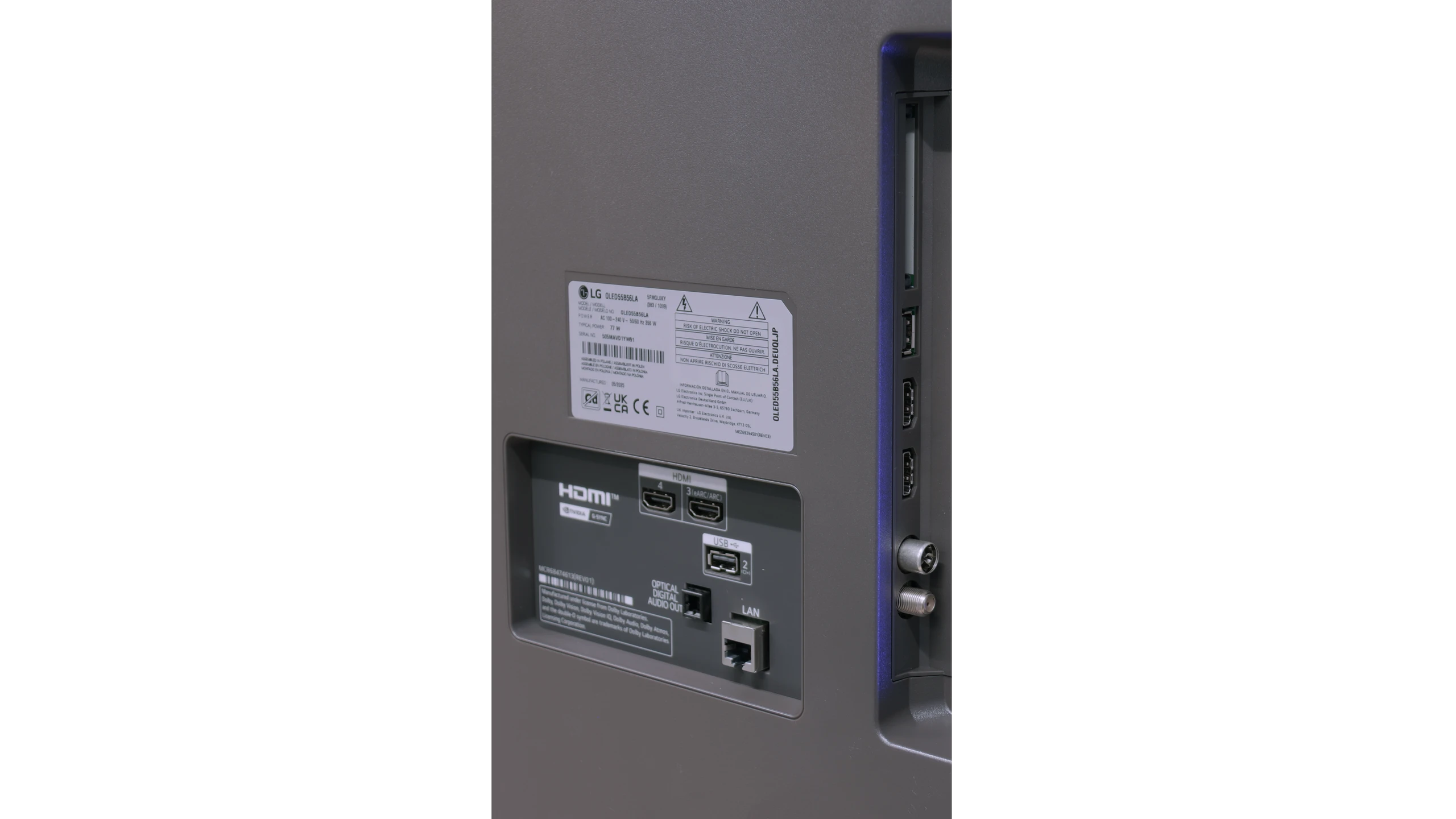



User features
Although the LG B5 is modern equipment, it hasn't forgotten about those who sometimes just want to... watch television. Without apps, without accounts, without logging in anywhere. It comes with built-in DVB-T2 tuners and the ability to record onto USB, along with a clear and fast EPG guide. Is that not enough? There’s even a working teletext – for many, probably a relic, for others, a daily necessity. We also appreciate the option to turn off the picture and leave just the sound, which is great for listening to music. And if you want to watch quietly – you can easily pair Bluetooth headphones, without a struggle with settings and without delays. Everything works as it should.
SMART TV: webOS
The biggest distinguishing feature of the webOS system – still! – is the way it is controlled. The Magic remote that comes with the LG B5 (in our version B56 – without a numeric keypad) works like a magic wand. You point, click, select. And it simply… works. Intuitively, quickly, and without unnecessary side-to-side clicking. Additionally, there’s an AI voice assistant – quite efficient. You can summon it directly from the remote and use your voice to search for content, change settings, or switch sources. WebOS may not be the most "modern" system on the market, and the built-in ads can be annoying, but when it comes to user convenience – especially with the Magic remote – it still outpaces the competition by a step.
Google TV and Smart Features
The OLED910 operates on the Google TV system, which is definitely its strong point. We have access to a huge library of applications, from popular streaming platforms to niche programmes. In addition, there is voice search and Google Assistant, which works really well and understands even less obvious commands like "check the weather" or "give me a horror movie suggestion for tonight". There is also support for AirPlay, which facilitates cooperation with Apple devices. Unfortunately, classic screen mirroring simply did not work in our tests, so we cannot count this aspect as a positive.
Classic Features
As for more traditional solutions, the OLED910 does not offer anything special. It has a rarely seen mini-jack headphone socket, which may be useful for seniors or those using older speakers. The remote has backlit buttons, which is convenient, but at the same time operates via infrared, so you have to aim at the screen, which seems anachronistic in 2025. Although you can use headphones and speakers on the TV simultaneously, unfortunately, only wired – wireless connection is not possible, which is a slight inconvenience as who would want to use wired headphones today? There is also a lack of PiP function and the ability to record materials to USB.
4-Sided Ambilight System
And of course, Ambilight. The OLED910 comes with a full four-sided system. It makes the television seem larger, and the content viewed gains additional depth and a more impressive character. The effect is really strong, especially when the television is mounted on the wall and the light fills the entire surroundings. It is one of those additions that is hard to give up once you have tried it.
Playing files from USB
8.6/10
9.5/10
Supported photo formats:
Maximum photo resolution:
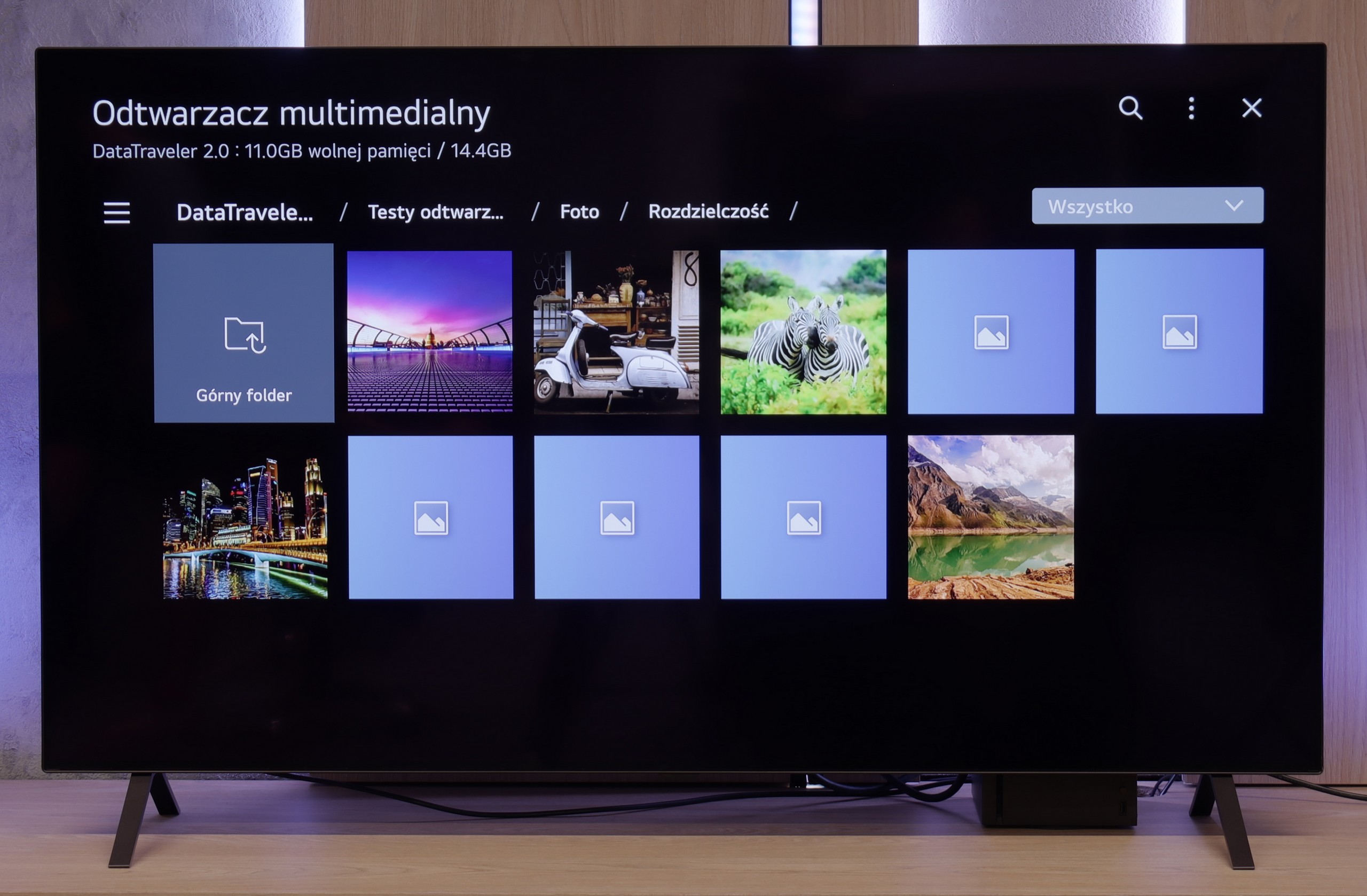

LG B5 handles files from USB as it should. Most popular formats work flawlessly, and subtitles – even with Polish characters – are displayed correctly. You can easily play a movie from a USB stick or have a weekend slideshow of your holiday photos without worrying that something will go wrong. However, there was a surprise with HEIC format files – that is, photos saved by Apple devices. While the LG C5 had no issues with them, the B5 stubbornly refused to cooperate and was unable to display them. A minor hiccup that probably won't affect everyone, but it's worth knowing about.
The OLED910 handles playback of files from a pendrive or a disk connected via USB with ease. It supports virtually all popular video, photo, and music formats, so you are unlikely to encounter something it cannot open. The player itself looks quite simple, almost clunky, but it operates efficiently. And if someone misses more advanced options, they can always download VLC or another program from the Google Play store.
Apps
9.1/10
9.6/10














































Sound
7/10
9.5/10
- Maximum volume-88dB
- Dolby Digital Plus 7.1
- Dolby True HD 7.1
- Dolby Atmos in Dolby Digital Plus (JOC)
- Dolby Atmos in Dolby True HD
- DTS:X in DTS-HD MA
- DTS-HD Master Audio
We weren't expecting miracles – after all, the LG B5 doesn’t have an advanced audio system, and its built-in speakers look... well, like those in most flat-screen televisions. And yet – it sounded really pleasant. The dialogues are clear, the sound doesn’t boom, and during a calmer viewing, we didn’t immediately feel the need to connect a soundbar. It's a pity that this year LG decided to cut something that worked in the previous generation. We're of course talking about support for DTS formats, which we will no longer find in the B5. If you have films encoded in this format – you'll need to rely on an external player.
This is one of the best-performing televisions we have had the opportunity to test in the editorial office. The built-in soundbar does all the work here, and it can comfortably be said that it can replace basic external audio systems. The sound is deep, clear, and truly enjoyable, and the collaboration with Bowers & Wilkins proves to be not just a marketing gimmick, but a real enhancement of sound quality. If someone would like to take a step further, Philips offers the possibility of connecting an external subwoofer thanks to a dedicated pre-out connection. With such a setup, it reaches a level that is hard to find in televisions – and one can confidently talk about truly cinematic experiences.
Acoustic Measurements
No acoustic data
88dBC (Max)
75dBC


